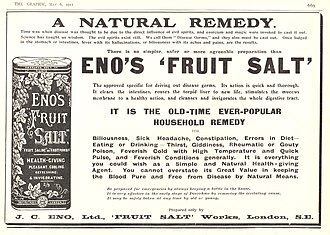Fruit salt
Fruit Salt[edit]

Fruit salt is a type of effervescent compound used as an antacid to relieve indigestion and heartburn. It is a mixture of sodium bicarbonate, citric acid, and other ingredients that react with water to produce carbon dioxide gas, creating a fizzy solution. This effervescence helps to neutralize stomach acid and provide relief from symptoms of dyspepsia.
History[edit]
The concept of fruit salt was popularized in the 19th century by James Crossley Eno, a British pharmacist. Eno developed his own formulation, which became widely known as "Eno's Fruit Salt." The product was marketed as a remedy for various digestive ailments and gained popularity due to its effectiveness and pleasant taste.
Composition[edit]
Fruit salt typically contains the following ingredients:
- Sodium bicarbonate: Acts as a base to neutralize stomach acid.
- Citric acid: Provides the acidic component that reacts with sodium bicarbonate to produce effervescence.
- Sodium carbonate: Sometimes included to enhance the antacid effect.
- Flavoring agents: Added to improve taste, often mimicking the flavor of citrus fruits.
Mechanism of Action[edit]
When fruit salt is dissolved in water, the sodium bicarbonate reacts with the citric acid to produce carbon dioxide gas, which causes the solution to fizz. This reaction can be represented by the following chemical equation:
\[ \text{NaHCO}_3 + \text{C}_6\text{H}_8\text{O}_7 \rightarrow \text{Na}_3\text{C}_6\text{H}_5\text{O}_7 + \text{H}_2\text{O} + \text{CO}_2 \uparrow \]
The carbon dioxide gas produced helps to mix the solution and can aid in the mechanical breakdown of stomach contents, while the resulting solution acts to neutralize excess stomach acid, providing relief from heartburn and indigestion.
Uses[edit]
Fruit salt is primarily used to:
- Relieve symptoms of indigestion and heartburn.
- Act as a mild laxative due to its effervescent properties.
- Provide a refreshing and palatable drink that can help with hydration.
Related Pages[edit]
| Anatomy of the gastrointestinal tract, excluding the mouth | ||||||
|---|---|---|---|---|---|---|
|
Ad. Transform your life with W8MD's Budget GLP-1 injections from $75


W8MD offers a medical weight loss program to lose weight in Philadelphia. Our physician-supervised medical weight loss provides:
- Weight loss injections in NYC (generic and brand names):
- Zepbound / Mounjaro, Wegovy / Ozempic, Saxenda
- Most insurances accepted or discounted self-pay rates. We will obtain insurance prior authorizations if needed.
- Generic GLP1 weight loss injections from $75 for the starting dose.
- Also offer prescription weight loss medications including Phentermine, Qsymia, Diethylpropion, Contrave etc.
NYC weight loss doctor appointmentsNYC weight loss doctor appointments
Start your NYC weight loss journey today at our NYC medical weight loss and Philadelphia medical weight loss clinics.
- Call 718-946-5500 to lose weight in NYC or for medical weight loss in Philadelphia 215-676-2334.
- Tags:NYC medical weight loss, Philadelphia lose weight Zepbound NYC, Budget GLP1 weight loss injections, Wegovy Philadelphia, Wegovy NYC, Philadelphia medical weight loss, Brookly weight loss and Wegovy NYC
|
WikiMD's Wellness Encyclopedia |
| Let Food Be Thy Medicine Medicine Thy Food - Hippocrates |
Medical Disclaimer: WikiMD is not a substitute for professional medical advice. The information on WikiMD is provided as an information resource only, may be incorrect, outdated or misleading, and is not to be used or relied on for any diagnostic or treatment purposes. Please consult your health care provider before making any healthcare decisions or for guidance about a specific medical condition. WikiMD expressly disclaims responsibility, and shall have no liability, for any damages, loss, injury, or liability whatsoever suffered as a result of your reliance on the information contained in this site. By visiting this site you agree to the foregoing terms and conditions, which may from time to time be changed or supplemented by WikiMD. If you do not agree to the foregoing terms and conditions, you should not enter or use this site. See full disclaimer.
Credits:Most images are courtesy of Wikimedia commons, and templates, categories Wikipedia, licensed under CC BY SA or similar.
Translate this page: - East Asian
中文,
日本,
한국어,
South Asian
हिन्दी,
தமிழ்,
తెలుగు,
Urdu,
ಕನ್ನಡ,
Southeast Asian
Indonesian,
Vietnamese,
Thai,
မြန်မာဘာသာ,
বাংলা
European
español,
Deutsch,
français,
Greek,
português do Brasil,
polski,
română,
русский,
Nederlands,
norsk,
svenska,
suomi,
Italian
Middle Eastern & African
عربى,
Turkish,
Persian,
Hebrew,
Afrikaans,
isiZulu,
Kiswahili,
Other
Bulgarian,
Hungarian,
Czech,
Swedish,
മലയാളം,
मराठी,
ਪੰਜਾਬੀ,
ગુજરાતી,
Portuguese,
Ukrainian